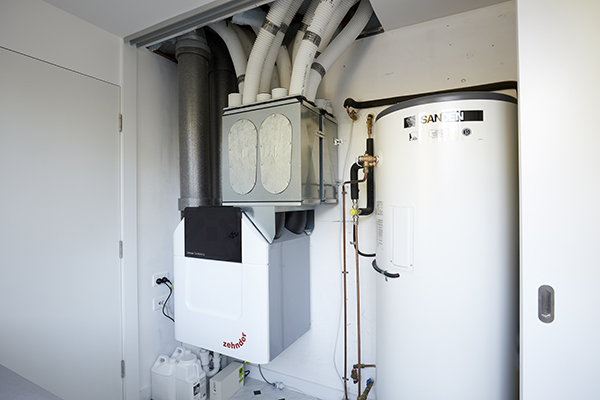Ways to Cut Costs with HRV in Warm Climates
The All-Inclusive Guide to the Uses of Heat Recovery Ventilation in Modern Structures
Heat Recovery Ventilation (HRV) systems stand for a significant development in developing technology (HRV Heat Recovery Ventilation). They supply a technique for exchanging stagnant interior air with fresh exterior air while reducing power loss. This method not just enhances indoor air top quality but also adds to power efficiency in both residential and industrial buildings. Understanding the various applications and advantages of HRV can disclose its vital function in modern-day design and sustainability initiatives. The ramifications of this innovation are worth checking out even more
Comprehending Heat Recovery Ventilation Solutions

Although several contemporary structures focus on power efficiency, recognizing warmth healing ventilation (HRV) systems is vital for maximizing indoor air high quality and decreasing energy consumption. HRV systems work by moving heat from stagnant interior air to inbound fresh air, successfully keeping comfortable indoor temperatures while decreasing energy loss. These systems include a warm exchanger, fans, and ductwork that promote the flow of air. During winter months, HRV units catch and reuse heat from the outward bound air, while in summer season, they can aid cool inbound air. By continuously exchanging air, HRV systems additionally minimize humidity and the concentration of interior pollutants. Appropriate installment and upkeep of HRV systems are important for their performance and performance in boosting general structure efficiency and comfort.
Advantages of Heat Recovery Ventilation
Heat recovery ventilation systems use countless benefits that boost both energy performance and indoor air top quality in modern-day buildings. By capturing and reusing power from exhaust air, these systems considerably decrease heating and air conditioning prices, leading to reduced power usage. They keep a constant circulation of fresh outdoor air, lessening the danger of interior air pollutants and allergens. This constant exchange aids control moisture degrees, avoiding mold development and ensuring a healthier living setting. Furthermore, HRV systems add to sustainability goals by reducing overall carbon footprints. Their ability to optimize air flow without compromising thermal convenience makes them a useful addition to contemporary building style, advertising both financial and ecological advantages.
Applications of HRV in Residential Buildings
As property owners progressively focus on energy effectiveness and indoor air top quality, the applications of heat recuperation air flow (HRV) systems in residential buildings have actually become extra widespread. HRV systems are particularly beneficial in tightly sealed homes, where maintaining fresh air blood circulation is vital for avoiding dampness build-up and indoor pollutants. They efficiently transfer warm from outbound stale air to incoming fresh air, lowering power costs associated with cooling and heating. Additionally, HRVs can boost comfort levels by controling humidity and temperature. They are likewise adaptable for various More about the author household layouts, including single-family homes and multi-unit buildings. Generally, incorporating HRV systems supports lasting living techniques while guaranteeing a much healthier interior environment for owners.
HRV in Industrial and Commercial Settings
In commercial and industrial setups, the implementation of warmth healing air flow (HRV) systems has become significantly essential for maximizing energy performance and maintaining air quality. These systems properly move warm from exhaust air to inbound fresh air, decreasing the requirement for extra home heating or cooling. This not only lowers energy costs but additionally contributes to sustainability campaigns. Industries such as production, warehousing, and office buildings profit greatly from HRV systems, as they assist manage temperature level and moisture degrees, ensuring a comfy and effective setting. In addition, HRV systems aid in getting rid of contaminants and excess dampness, boosting indoor air high quality. As regulations around air top quality end up being stricter, the fostering of HRV modern technology is most likely to expand, making it an important element of modern-day industrial and commercial framework.
Future Fads in Heat Recovery Ventilation Innovation

Often Asked Questions
Just How Does Heat Recovery Ventilation Impact Indoor Air Quality?
Heat recovery ventilation considerably improves indoor air high quality by continuously trading stagnant indoor air with fresh outside air while recovering power. This process reduces look here pollutants, maintains suitable moisture levels, and ensures a much healthier environment for occupants.
Can HRV Equipments Be Mounted in Existing Structures?
HRV systems can indeed be installed in existing buildings. Retrofitting may need adjustments to ductwork and ventilation layouts, but it significantly boosts energy effectiveness and interior air top quality, making it a sensible choice for older frameworks.
What Maintenance Is Required for HRV Equipments?

Exist Details Climates Where HRV Is Extra Effective?
Heat recovery ventilation systems are especially efficient in climates with substantial temperature level distinctions in between periods. These systems optimize energy effectiveness by recuperating heat from exhaust air, making them perfect for both cool and moderately warm environments.
Just How Do HRV Solutions Affect Energy Costs?
